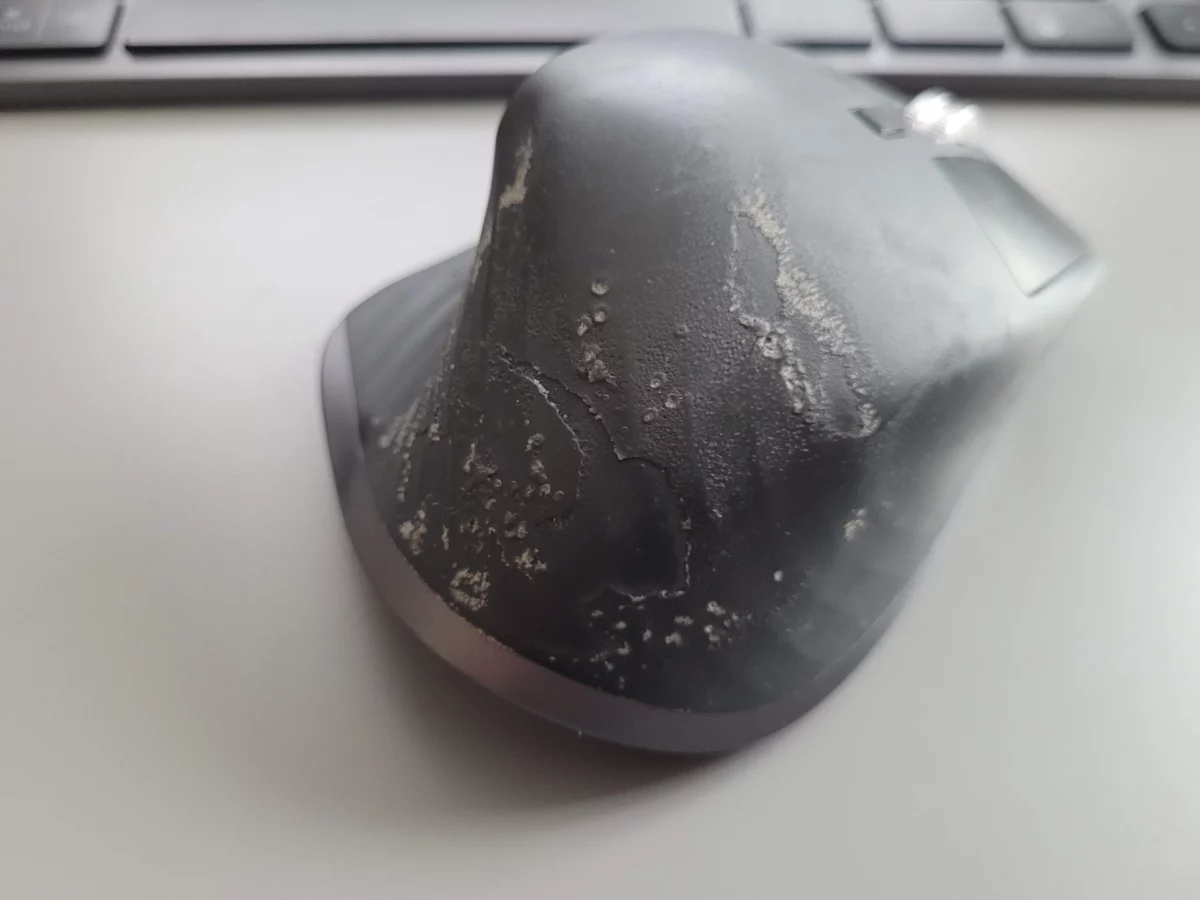I’ve tried countless mice, from Apple’s “upside-down charging” to RGB gaming ones, but nothing felt right for video editing. Then I discovered the Logitech MX Master 3S, and I can confidently say it’s the best mouse for video editing.
This mouse isn’t just about ergonomics (although it’s incredibly comfortable). It’s packed with features designed specifically for video editors.
- Customizable buttons that become your editing shortcuts? Check.
- A scroll wheel that lets you fly through footage or make micro-adjustments with ease? Double-check.
Buckle up, because I’m about to show you why the MX Master 3S is the best mouse for video editing, IMHO… and the video editing mouse you’ve been dreaming of.
Key features of the Logi MX Master 3S
- Ergonomic Design: Sculpted shape for all-day comfort.
- MagSpeed Scrolling: Ultra-fast and precise for navigating long timelines, with side-to-side scrolling.
- Customizable Buttons: Program shortcuts for your favorite editing software.
- App-Specific Profiles: Optimize workflows across different applications.
- Darkfield Tracking: 8000 DPI sensor tracks on virtually any surface, even glass.
- Quiet Clicks: 90% less click noise for distraction-free editing.
- Wireless Connectivity: Bluetooth or Logi Bolt USB receiver options.
- Long Battery Life: Up to 70 days on a single charge.
Why The Logi MX Master 3S Is The Best Mouse for Video Editing
I’ve been a loyal MX Master user since 2017, upgrading from the 2S to the 3, and now to the 3S.
In all that time, I’ve never felt the urge to switch to another mouse for video editing. It’s been my trusty companion through countless hours of editing in Final Cut Pro X, and it consistently delivers on precision, comfort, and efficiency.
The ergonomic design feels like it was molded to my hand, preventing fatigue even during marathon 12-hour editing sessions. The side buttons are perfectly positioned for my thumb, and I’ve assigned them to zoom in and out—a feature I use constantly when fine-tuning cuts and transitions.
But the real magic lies in the thumb scroll wheel.
It allows me to effortlessly scroll horizontally through the timeline, making navigation a breeze. Once you get used to it, it’s hard to imagine editing without this feature.
The main scroll wheel’s MagSpeed scrolling is equally impressive, letting me zip through footage at lightning speed or slow down for precise frame-by-frame adjustments.
The MX Master 3S has become an extension of my hand, seamlessly integrating into my editing workflow. It’s a mouse I can rely on, and I can confidently say it’s the best video editing mouse I’ve ever used.
Customize Your MX Master 3S for Any Software
Whether you’re loyal to Adobe Premiere Pro, exploring the depths of DaVinci Resolve, or sticking with Apple’s Final Cut Pro X, this mouse has your back.
The real power of the MX Master 3S lies in its seamless integration with Logi Options+ software.
Within this software, you can create custom profiles tailored to each editing application. This means you can assign specific functions to each button and scroll wheel direction, optimizing your workflow for the software you’re using.
One often-overlooked gem of the MX Master 3S is the “gesture button” located under your thumb.
A simple click activates it, and then by moving your mouse in any direction (up, down, left, or right), you unlock a whole new set of customizable actions. This effectively gives you up to five additional button options, making it possible to perform virtually any editing task without ever having to reach for your keyboard.
This level of customization means you can create a truly personalized editing experience. Assign your most-used shortcuts, tools, or even macros to the mouse’s buttons, and watch your efficiency soar.
No more fumbling for keyboard shortcuts or navigating through menus—everything you need is right at your fingertips.
What I LOVE About My MX Master 3S
Beyond its performance in video editing, there are a few things about the MX Master 3S that make me absolutely love it:
- The Fast Charging Is Legit: Seriously, 5 minutes of charge gives me enough juice to power through days of work. I barely even think about charging this mouse, maybe once every couple of months. This is a lifesaver when you’re in the zone and don’t want to interrupt your flow.
- Wired When You Need It: Even though it’s wireless, you can still plug in the USB-C cable and use it while it charges. No downtime waiting for it to juice up—just plug and play.
- Three Devices, No Problem: I love that I can seamlessly switch between my MacBook Pro, Mac Mini (I upgraded to the M4 Pro version, read my Mac Mini M4 review for video editing), and even my girlfriend’s laptop when she’s working from my place (and forgets her mouse, of course)..
- Customization Galore: The custom buttons are where the MX Master 3S truly shines for me. I’ve got my side buttons set up for forward and back navigation in Chrome, and the gesture button under my thumb is programmed to take a screenshot.
These are just a few of the reasons why the MX Master 3S has earned a permanent spot on my desk. It’s not just a mouse; it’s an essential tool that helps me work smarter, not harder.
What I Don’t Like About My MX Master 3S
While the MX Master 3S is a fantastic tool, it’s not without its flaws:
- Bulky for Travel: This mouse isn’t exactly pocket-friendly. It’s a bit on the large side, making it awkward to toss in a bag for work at a client’s place or a coffee shop. You’ll definitely need a case to protect it (like this cheap one from Hermitshell) if you plan on taking it with you.
- Coating Issues: The rubberized coating on the mouse isn’t the most durable. It’s prone to wear and tear over time, and many users have reported this issue on Logitech’s support forums. Unfortunately, mine is no exception.
- Overly Sensitive Buttons: The buttons are designed for responsiveness, which is great for editing. However, they can be a bit too sensitive at times. Just resting my fingers on them can sometimes trigger a click, which can be annoying when I’m not actively working and just want to relax (while watching a YouTube video, for example).

While these drawbacks aren’t dealbreakers for me, they’re worth considering before you invest in the MX Master 3S.
If portability or button sensitivity is a major concern, you might want to explore other options like the MX Anywhere 3S (Amazon link). However, if you prioritize comfort, customization, and efficiency for your video editing workflow, the MX Master 3S is still the best mouse for video editing, IMHO.
Mac or PC? No Problem!
The MX Master 3S comes in two flavors: a Mac-specific version and a regular one. Here’s the thing: you don’t really need the Mac version. The regular MX Master 3S works flawlessly with both macOS and Windows via Bluetooth.
Bluetooth or Unifying Receiver?
I’ve personally never even bothered with the included Unifying Receiver. Bluetooth connectivity has been rock-solid for me, and I doubt I’ll ever have a need for the supplied dongle.
The Importance of Choosing the Right Mouse for Video Editing
Why should video editors care about their mouse?
Video editing involves long hours of precise clicking, dragging, and scrolling. A subpar mouse can lead to discomfort, fatigue, and even repetitive strain injuries.
Choosing the right mouse can significantly impact your productivity, comfort, and overall health. A good mouse should be ergonomic, offer precise tracking, and have customizable buttons for quick access to essential editing functions.
What are the key features to look for in a video editing mouse?
- Ergonomics: The mouse should fit comfortably in your hand and support your wrist to prevent strain during long editing sessions.
- Precision: Accurate tracking is crucial for precise editing, especially when working with timelines and making fine adjustments.
- Customization: Programmable buttons allow you to create shortcuts for frequently used editing functions, saving you time and effort.
- Scroll wheel: A smooth and responsive scroll wheel is essential for navigating through timelines and scrubbing through footage.
- Wireless connectivity: A wireless mouse offers greater freedom of movement and reduces cable clutter on your desk.
Frequently Asked Questions
What is the difference between laser and optical mice for video editing?
Optical mice use a light sensor to track movement, while laser mice use a laser.
Optical mice are generally preferred for video editing due to their more consistent tracking and better performance on various surfaces.
Can I use a gaming mouse for video editing?
While gaming mice are designed for speed and precision, they may not be the most ergonomic option for long editing sessions. However, some gaming mice, like the Logitech G Pro Wireless and Logitech G502, offer excellent performance for video editing.
Can I use a regular mouse for video editing?
You can… but you’re not gonna have a great time editing, and it comes down to the thumb wheel on the MX Master 3S.
One of the only options that can work is the Logitech M650 L. When you hold either the “forward” or “back” buttons (very useful for Internet browsing), and then scroll the main wheel, it acts like a thumb wheel – aka horizontal scrolling.
It’s not ideal, but pretty good if you’re on a budget. You can often get for less than $35. I would go for the L version, so that your hand doesn’t cramp after a few minutes of work.
Should I choose a wired or wireless mouse for video editing?
Wired mice offer a more stable connection and don’t require batteries, but they can be less convenient due to the cable.
Wireless mice offer more freedom of movement but may experience occasional lag or require charging/battery replacement. But today’s wireless mice are so good that you would do yourself a disservice by choosing a regular mouse.
Do I need a mouse with a high DPI for video editing?
DPI (dots per inch) refers to the sensitivity of the mouse sensor. A higher DPI means the cursor moves faster on the screen.
While a high DPI can be helpful for some tasks, it’s not necessarily essential for video editing. Most editors find a DPI between 800 and 1600 to be comfortable and precise.
Is a trackball a good alternative to a mouse for video editing?
Trackballs offer a different way to control the cursor, using a ball that you roll with your thumb or fingers. Some video editors find trackballs more comfortable and ergonomic than traditional mice.
If you experience wrist pain or fatigue, a trackball might be worth considering over an ergonomic mouse.
Can I use the Apple Magic Mouse for video editing?
While technically usable for video editing, the Apple Magic Mouse is far from ideal. Its sleek design sacrifices comfort for extended use, leading to hand fatigue.
The lack of customizable buttons and horizontal scrolling further hinders efficient editing workflows. It might be fine for casual use, but serious video editors will want a more specialized tool.

